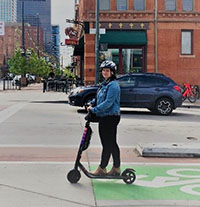

Micromobility is an important component of a safe, healthy, accessible, connected, and reliable multi-modal transportation system. The Federal Highway Administration (FHWA) is playing a leading role in sharing information and resources, convening stakeholders, and conducting research related to micromobility.
Micromobility includes any small, low-speed, human or electric-powered transportation device that people use to get to and from a destination, including bicycles, scooters, electric-assist bicycles (e-bikes), electric scooters (e-scooters), and other small, lightweight, wheeled personal conveyances.*
Shared micromobility refers to fleets of micromobility devices that are available to the public for shared use. Operators deploy shared micromobility fleets in defined service areas to provide transportation options for local trips and to provide connections to other modes of transportation (e.g., public transit). Fleets are predominantly distributed in public rights-of-way near transit stops and stations, adjacent to sidewalks in well-traveled areas, or in public scooter and bike parking corrals. Devices may be stationed at a fixed dock or float in "dockless" systems.
Key Issues Related to Micromobility


Visit the FHWA Micromobility Fact Sheet to learn more about each of these key issues.

*Note: The term "scooter" can mean different things to different people. It could be an e-scooter, a mobility-aid type scooter, or even a moped or motor scooter (which are actually motor vehicles and people on them are motor vehicle occupants and not non-motorists). The National Highway Traffic Safety Administration (NHTSA) National Center for Statistics and Analysis (NCSA) and the State Departments of Transportation use the term "personal conveyance" for e-scooters and other devices designed for non-motorist use (excluding the moped and motor scooter). Examples include e-scooters, ridable toys, skates, skateboards, baby carriages, two wheeled, self-balancing-style devices, wheelchairs, and mobility-aid scooters.